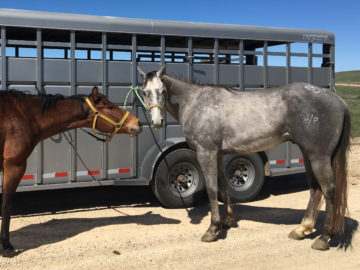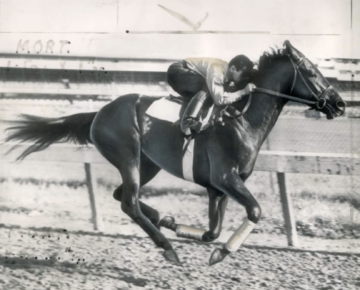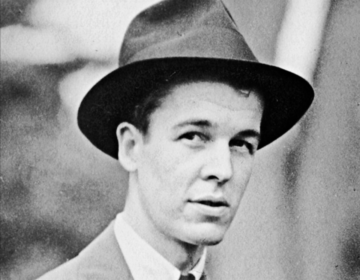by Mark Harvey

About five years I bought a quarter horse at an auction in Billings, Montana. The horse was a tall gray four-year-old and showed tremendous speed in the roping events prior to the auction. Kind of a hyped-up, ears-back creature but obviously athletic. Horse auctions are exciting because there’s a lot of money on the line, high stakes, and all kinds of ways things can go wrong. The very term “horse trader” implies clever rogues who have a million ways to disguise old injuries and have no qualms about fobbing off real outlaws as loyal steeds who will always meet you at the gate and never buck.
The horse I bought that day went for a good price and was a registered quarter horse. The name on his papers was JP Perry Bueno, which in the traditional style was a combination from the names of the horse’s sires and dams. His sire was Top Perry and his grandsire was Mr. Jess Perry (hence the JP). I assume the Bueno part was a play on the grandsire of his dam, which was Chicks Beduino. I decided to call him Tatonka for no good reason other than I liked the sound of it. I had looked at his lineage briefly and was familiar with some of his dams and sires but not all.
When I brought the horse back to Colorado he was wired. New locales and new herds stress horses of any age. I was nervous riding him the first few times and, sure enough, he was high-strung and ready to rip at the lightest touch of the legs. But he was fun and could really run. He didn’t look like much of a quarter horse with his long legs and slim build.

That got me curious so I dove into his lineage. Turns out, he was the descendant of Native Dancer, considered to be one of the best American racehorses ever. In his entire career, Native Dancer won 21 races and only lost one race: The 1953 Kentucky Derby. And he lost it by just a nose to the 25-1 odds-against horse Dark Star after getting bumped by Money Broker, a 45-1 odds-against horse, early in the race. But he won the Preakness and Belmont and all the other stakes races he entered. Native Dancer was born in 1950, 11 generations prior to Tatonka. Obviously, genes are diluted by eleven generations, but Tatonka looks a lot like Native Dancer, especially his color. Both are/were gray horses and Native Dancer’s nickname was “The Gray Ghost.” Native Dancer had a much thicker neck, was much taller at 16.3 hands and was generally more heavy-muscled than Tatonka. In fact, Native Dancer looks more like a quarter horse than Tatonka.
Not only was The Gray Ghost a great runner, but he was a great progenitor as well. Three of his progeny, Northern Dancer, Kauai King, and Majestic Prince all won two of the three Triple Crown races in their careers. Native Dancer’s grandson, Mr. Prospector, was a tremendous progenitor too and fathered more than a thousand named colts. So desired were Prospector’s genetics that by 2018, every entrant in the Kentucky Derby had some biological connection to him and hence to Native Dancer.

But thoroughbreds are notoriously inbred. Every thoroughbred alive today is an offspring of just three stallions: Darley Arabian, Godolphin Arabian, and Byerley Turk, and a select number of mares dating back to 17th and 18th century England. Darley Arabian and Godolphin Arabian were both said to have come from Yemen. The origins of Byerly Turk are less known although he was captured in the Battle of Buda in Hungary.
In a study published by Scientific Reports of more than 10,000 thoroughbreds over a 50-year period, geneticists discovered that the Thoroughbreds are becoming still more inbred due to the high pressure and money involved in producing winning horses. The scientists looked for homozygosity and identical alleles among the 10,000 horses and noticed that in particular, the last fifteen years have seen increases in those genetic traits.
Registered Quarter Horses have much more genetic diversity, or haplotype richness as geneticists put it, than thoroughbreds. The quarter-horse breed has only been official since 1940, although the aim to breed a quarter-horse-type animal has been going on since the colonial era. And today there are more than six million registered quarter horses, making it the most popular horse breed.
The Quarter Horse lineage comes from English stock horses bred with Chickasaw horses in the American colonial era. Then a thoroughbred descendant of Godolphin was introduced to the breed. Finally, blood from western mustangs was introduced. But it may have been the original breeding of the Chickasaw Indians with horses captured from the Spanish conquistadors that created the foundation of the American Quarter Horse. The Chickasaw loved to race their horses on short straight courses and the American settlers soon picked up on the sport. The Chickasaw horses with their stocky build were the fastest over those short courses and in high demand.

Native Dancer was owned by Alfred Gwynne Vanderbilt, the grandson of Cornelius Vanderbilt II, once considered the richest man in the world. Alfred was passionate about horse racing his entire life and was considered one of its most successful breeders. He inherited Sagamore farms when he was only 21 and turned it into a legendary breeding and training center. He was twice the leading money-winning horse owner in the United States: once in 1935 and again in 1953.
Literally to the day he died, Vanderbilt loved to visit the track to watch his horses do their morning workouts. That’s what he did on November 12th, 1999, the day he died.
Vanderbilt owned lots of great horses but none greater than Native Dancer. He said, “If he had won the Derby, Native Dancer’s record would be the record by which all horses are judged.”
The jockey who rode Native Dancer in all three of the Triple Crown races was Eric Guerin, since inducted into the Jockey Hall of Fame. Guerin won an astonishing 2,712 races in his career. I’ve met a few world-class jockeys, and in my opinion, there is not a tougher, more fearless breed on the face of the planet. These wee men and women shy of 125 pounds have the courage of lions. The thought of getting on one of these overbred thoroughbreds to race thousands and thousands of times at speeds of more than 40mph makes most of our adventures seem like sipping sarsaparilla at a church picnic.

Despite his huge success as a jockey, including winning the 1947 Kentucky Derby, Guerin’s loss on Native Dancer at the Kentucky Derby dogged him to the end. Describing Guerin’s tactics at the Kentucky Derby, one critic wrote, “Eric took Native Dancer everywhere at Churchill but the ladies’ room.” In a 1973 interview with Sports Illustrated, Guerin said, “I guess I’ve had maybe 2,000 interviews since [the 1953 Kentucky Derby], and every time it begins with, ‘What about the Dancer and the Derby?’ But I don’t mind. To tell you the truth, I never get tired of talking about that horse. I guess he’ll always be my favorite subject.”
Tatonka lives in a much more humble setting than what his great ancestor enjoyed at Sagamore Farms. He has better scenery with the Colorado mountains but has never had a blanket for the winter, gets only a cursory brushing on days when he’s ridden, and will never be in any hall of fame.
I wish I could tell you that Tatonka turned out to be a great horse. But he didn’t. He could always run like the devil in a straight line; at a full gallop, you were riding the wind. Like his famous prize-winning gray ghost ancestor, his gallop is rough. But he never became a good ranch horse. Ranch horses are asked to do much different things than Preakness winners. They’re asked to follow cattle and cross very rough terrain, and stay cool when things explode.
Tatonka isn’t very good at the following cattle bit. Some ranch horses are described as “cowy” for their laser-like focus on the cow at hand and their ability to anticipate a cow’s move one way or the other. Maybe his resident mind is on some race track from his historical sire, but Tatonka has no interest in cattle. We spent hours in pens with various steers trying to interest him in becoming a cutting horse, but it never happened. In retrospect maybe I should have guessed that in a body shaped to go all forward and straight ahead, he wouldn’t make a great ranch horse.
One thing I never expected out of the loins of Native Dancer was a horse with the disposition of a sweet couch potato better suited for clover pastures than the starting gates at Churchill Downs. After about three years, Tatonka metamorphized from a too-wired racer into an 1,100-pound golden retriever. Whereas my other horses play a silly game of tag when being caught in the corrals, Tatonka plods up to me as if I’m his mother and nearly puts the halter on himself. But genes are genes, alleles are alleles and chromosomes are chromosomes. It turns out that the great Native Dancer had a lazy streak too. In the Sports Illustrated interview, Guerin said, “It’s really strange: until that day he was the laziest horse in a workout you could find—always playing, never serious. If he didn’t have another horse to work with, he just wouldn’t work. And if the other horse stopped, he’d stop.”

It’s hard to judge a horse’s intelligence and I think horse owners anthropomorphize like crazy. I know I do. I have one very aloof horse named Mr. Blue whom I’m convinced smokes those nasty French Gauloises cigarettes and reads (and writes for) literary magazines when I’m not looking. Nevertheless, I don’t think Tatonka is very smart. He’s always a little slower than the other horses about everything. When it comes to being sweet, compliant, and easy to catch, he wins the triple crown. But reflective genius, he aint.
It is remarkable, though, that a horse bought in Billings, Montana, at auction has so much history dating back to sires from Yemen, Chickasaw horses, one of America’s greatest racehorses, and the Vanderbilt family. And that’s just one of his ancestors. The other dozens of dams and sires in his lineage each have their own history.
At his memorial service, Eric Guerin’s son said, “I would like to think that, somewhere, my father is riding Native Dancer right now. And, Dark Star, you don’t have a chance this time.”
